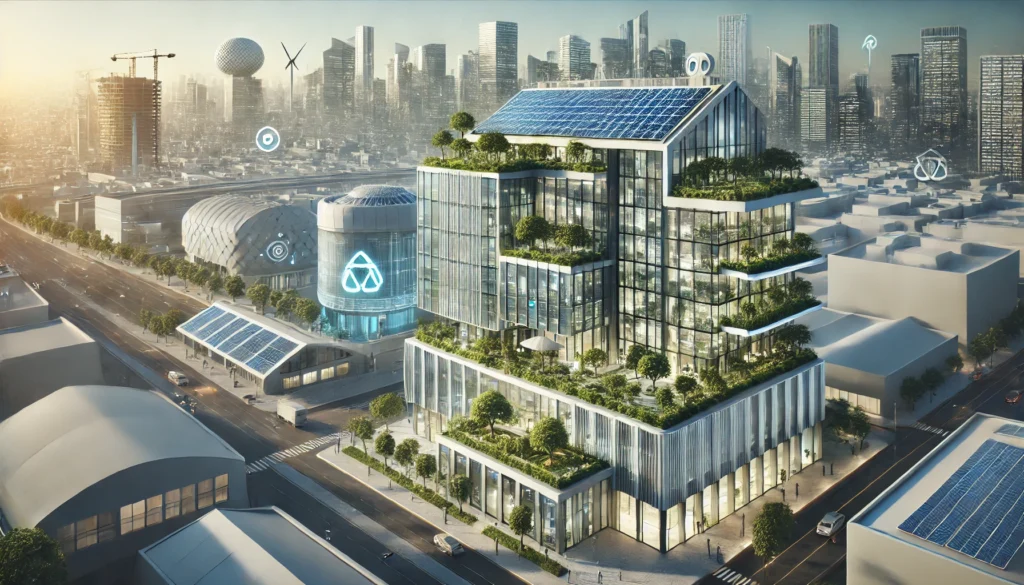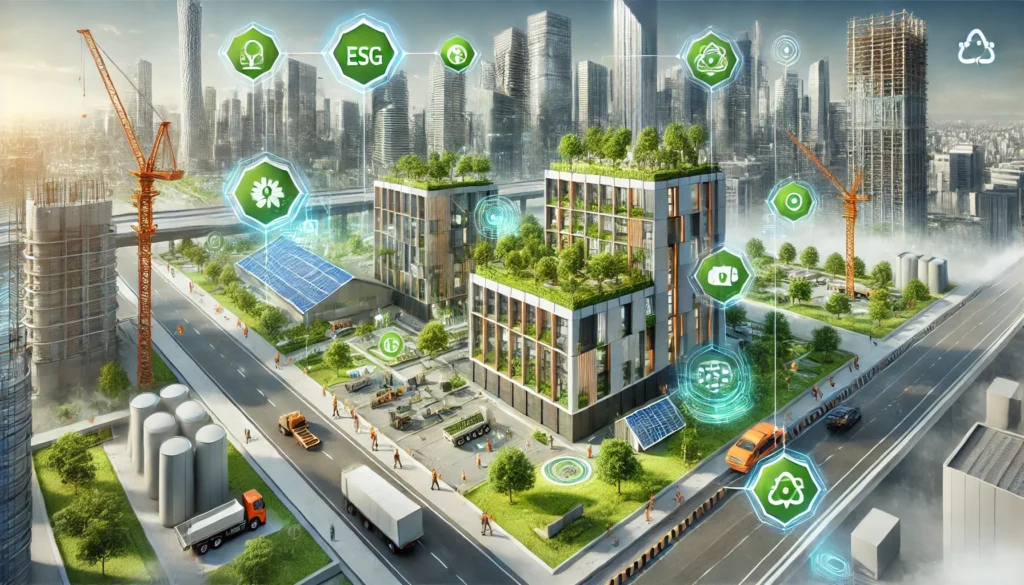As the world becomes increasingly aware of various industries’ environmental, social, and governance (ESG) impacts, the construction sector finds itself at the forefront of these discussions. The built environment contributes significantly to global carbon emissions, resource consumption, and waste generation. Integrating ESG principles into construction practices is no longer optional but essential for achieving long-term sustainability and meeting regulatory expectations. This blog outlines how ESG frameworks and international standards are shaping the future of construction, ensuring that the industry minimizes its negative impacts and contributes positively to global sustainability goals.
Why ESG Matters in Construction
According to the World Green Building Council, the construction industry has an outsized impact on the environment, accounting for nearly 39% of global carbon emissions. It also consumes vast amounts of natural resources and generates substantial waste. Given these realities, integrating ESG principles into construction practices is vital to drive sustainable development, reduce environmental footprints, and enhance social responsibility (Allianz Commercial)(ISAKCO).
Key Drivers for ESG in Construction:
- Environmental Impact: Construction projects consume energy and water, produce significant waste, and generate pollution. ESG principles help mitigate these effects through sustainable design, material selection, and efficient resource management.
- Social Responsibility: Ensuring worker safety, promoting fair labour practices, and engaging with local communities are critical social aspects. Projects aligned with ESG goals also aim to improve the health and well-being of occupants.
- Governance: Transparency, accountability, and ethical conduct are increasingly important as stakeholders demand higher governance standards. Construction firms must now report on ESG metrics and align with global standards to attract investors and mitigate risks.
International Standards for ESG Compliance in Construction
Various international standards and frameworks guide construction companies in integrating ESG principles. Some of the most prominent standards include:
1. LEED (Leadership in Energy and Environmental Design)
LEED, developed by the U.S. Green Building Council, is one of the most recognized green building certification programs worldwide. It focuses on reducing environmental impacts by improving energy efficiency, water use, CO2 emissions, and indoor environmental quality. LEED-certified buildings are considered a benchmark for sustainability in both residential and commercial projects (ISAKCO).
2. BREEAM (Building Research Establishment Environmental Assessment Method)
Originating in the UK, BREEAM provides a holistic assessment of a building’s environmental, social, and governance performance across its life cycle, from construction to operation. BREEAM evaluates factors such as energy consumption, water management, pollution, transportation, materials, and ecological impacts. Its flexibility allows for application across a wide range of building types and geographical locations (ISAKCO).
3. WELL Building Standard
The WELL Building Standard emphasizes the health and well-being of building occupants. It assesses elements such as air quality, water quality, lighting, fitness, comfort, and mental health considerations. WELL certification is especially relevant in the context of corporate ESG strategies that prioritize social responsibility (ISAKCO)(Home | Standards Australia).
4. ISO Standards
The International Organization for Standardization (ISO) offers several standards that align with ESG goals, particularly in environmental management (ISO 14001), energy management (ISO 50001), and sustainability in buildings and civil engineering works (ISO 21930). These standards provide a comprehensive framework for implementing sustainable practices throughout the project lifecycle (Home | Standards Australia).
Benefits of ESG Integration in Construction
1. Improved Environmental Performance Adopting ESG principles helps reduce the environmental impacts of construction projects by promoting resource efficiency, minimizing waste, and lowering greenhouse gas emissions. Energy-efficient buildings not only reduce operational costs but also contribute to global climate targets (Allianz Commercial)(ISAKCO).
2. Enhanced Social Responsibility The social aspects of ESG focus on improving worker safety, promoting diversity, and ensuring fair labor practices. Projects that consider the well-being of the community and occupants—such as by incorporating green spaces, safe working conditions, and wellness-focused designs—help create more inclusive and healthier environments (ISAKCO).
3. Stronger Governance and Risk Management Effective governance ensures that construction companies operate transparently and ethically, complying with legal and regulatory requirements. ESG-aligned projects typically involve rigorous auditing, reporting, and compliance measures, which can protect companies from legal risks and enhance their reputation (McKinsey & Company).
4. Market Competitiveness and Investor Confidence ESG-compliant construction projects are increasingly attractive to investors who seek long-term returns and lower risk profiles. Sustainable buildings often command higher market values, attract better tenants, and reduce operating costs, making them more competitive in the real estate market (McKinsey & Company).

Key Challenges in Implementing ESG in Construction
Despite its benefits, integrating ESG principles into construction projects comes with challenges:
- Cost Considerations: Initial investments in sustainable materials, energy-efficient systems, and certifications can be high. However, long-term savings in energy and maintenance costs often offset these upfront expenses(ISAKCO).
- Regulatory Complexity: Different countries have varying regulations and standards regarding ESG in construction. Navigating these regional differences requires expertise and continuous monitoring(Home | Standards Australia).
- Technological Advancements: The construction industry is evolving with the adoption of smart technologies, such as Building Information Modeling (BIM) and Internet of Things (IoT)-enabled devices, which can enhance ESG performance but also require significant investment in technology and training(Allianz Commercial).
The Future of ESG in Construction
As the global focus on sustainability intensifies, several trends are expected to shape the future of ESG in construction:
- Net-Zero and Positive Energy Buildings: The push for net-zero energy buildings, which generate as much energy as they consume, is gaining traction globally. These buildings are at the forefront of sustainable design and are becoming a key focus for developers(ISAKCO).
- Circular Economy: Construction companies are increasingly adopting circular economy principles, which emphasize reducing waste and reusing materials. This approach is both environmentally sustainable and cost-efficient(Allianz Commercial).
- Smart Building Technologies: The integration of AI-driven energy management systems and IoT devices is revolutionizing the construction industry by improving operational efficiency and reducing energy consumption(Allianz Commercial)(Home | Standards Australia).
Conclusion
The integration of ESG principles in construction is no longer optional—it’s essential for meeting sustainability goals, minimizing environmental impacts, and ensuring long-term success. With the adoption of international standards such as LEED, BREEAM, and ISO, the construction industry is making significant strides in creating buildings that are not only environmentally sustainable but also socially responsible and economically viable. As the industry evolves, embracing smart technologies, net-zero building designs, and circular economy practices will be critical for staying competitive and achieving ESG success.
FAQs
1. What are ESG principles in construction? ESG in construction refers to the integration of environmental, social, and governance factors in the planning, design, and execution of construction projects to promote sustainability, social responsibility, and transparency.
2. How do LEED and BREEAM certifications differ? While both LEED and BREEAM assess the sustainability of buildings, LEED is widely used globally, with a focus on reducing energy use and CO2 emissions. BREEAM, originally from the UK, provides a more comprehensive assessment that includes social governance, energy, and ecological impacts.
3. What is the importance of ESG for investors in construction? ESG compliance in construction can attract investors by reducing project risks, enhancing market value, and aligning with global sustainability trends. Investors increasingly prioritize companies that meet high ESG standards.


